Lynn Garrison
Lynn Garrison | |
|---|---|
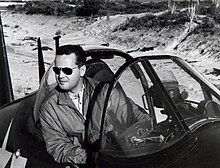 Lynn Garrison in the cockpit of his Corsair N693M at the National Air Races in Reno, Nevada, 1966 | |
| Born | April 1, 1937 |
| Allegiance | Canada |
| Service | Royal Canadian Air Force United Nations Emergency Force |
| Years of service | 1954–1964 |
| Rank | Wing Commander |
| Unit | 403 City of Calgary Squadron |
| Awards | Paul Tissandier Diploma |
Lynn Garrison (born April 1, 1937) is a Canadian pilot and political adviser. He was a Royal Canadian Air Force fighter pilot in the 403 City of Calgary Squadron, before holding jobs as a commercial pilot, film producer, director and mercenary. Later he became a political adviser in Haiti, and is now an author. With regard to flying, Garrison is known for his oft-repeated comment, "If it has fuel and noise, I can fly it."
Military career
Throughout the Second World War, Garrison's family hosted student pilots from the British Commonwealth Air Training Plan during their fortnightly leave. Contact with these pilots stimulated young Lynn's interest and by the age of four, he had decided he would be a pilot. During April, 1946 his parents purchased a ride for him in an ex-RCAF Cessna AT-17 operated by Kepler Aviation, at Calgary International Airport.

At the age of 17, Garrison joined the RCAF and trained at the RCAF Officer Selection Unit (Ontario) and Course 5411, 4 Flying Training School (RCAF Station Penhold, Alberta) and then the 2 Advanced Flying School (Portage la Prairie, Manitoba) for jet aircraft training (in the Canadair CT-133 Silver Star).
Garrison received his wings on 6 April 1955 making him the youngest "winged pilot" in the RCAF since World War II, a record that still remains. Garrison's wings were presented by Wing Commander Joe McCarthy DSO, DFC, CD, a second world war veteran who was famous for attacking the Sorpe dam on the Dambuster's raid.
After completing additional training in the F-86 at RCAF Station Macdonald, Manitoba, Garrison returned to 403 City of Calgary Squadron, where he served for 10 years from 1954 until 1964.
On April 1, 1958, Garrison piloted the last Canadian military flight of the Hawker Sea Fury. The specific aircraft was WG565, now displayed in Calgary.
On July 4, 1964, Garrison captained the last RCAF flight of the Avro Lancaster with Flight Lieutenant Ralph Langemann as co-pilot. Specially authorized by Minister of National Defence, Paul Hellyer, the flight was made more difficult by the fact that Garrison had never flown a Lancaster and had broken his ankle the previous day. Hellyer and Air Commodore John Emilius Fauquier DSO and Bar, DFC and Bar visited Calgary to witness the flight.
In his classic, Fighter Command Air Combat Claims, 1939–45 (1939–1940), John Foreman commented on the question of pilot temperament and ability. Foreman observed that Garrison had once remarked, "In every squadron there were, perhaps, four or five pilots who exuded confidence. They knew that they were going out to shoot. The rest knew sub-consciously, that they would make up the numbers, mill about, and get shot at".[1]
Post-military career
In 1960, Garrison obtained a contract to ferry 75 P-51 Mustang aircraft, retired from RCAF service, to their new owners in New York. Milt Harradence, took time off from his law practice to accompany Garrison on the trips. Flying without radios for much of the time, they navigated by following the Canadian Pacific Railway tracks eastward. Harradence and Garrison acquired two Mustangs as part of their compensation and registered them "CF-LOR" and "CF-LOQ";[2] the first of their type registered in Canada.
While ferrying surplus Mustangs from the old RCAF Station Macleod, Harradence and Garrison noted a number of Avro Lancaster bombers heading into the melting pot. Garrison purchased Lancaster FM-136 in 1960 and ferried it to Calgary where, with the help of Harradence and Arthur R. Smith MP, he created the Lancaster Memorial Fund. The Lancaster is a permanent display in Calgary as a memorial to those who served with the British Commonwealth Air Training Plan during the Second World War.
In 1962, Garrison served with 115 Air Transport Unit of the United Nations Emergency Force (UNEF), on the Sinai Peninsula, where he flew de Havilland Otters and Caribous. While with 115 ATU he acted as Under-Secretary-General of the United Nations Dr. Ralph Bunche's pilot.[3]

During 1963, Garrison, with authorization from Paul Hellyer and the help of RCAF 121 Search & Rescue Unit, assisted with the salvage of a Vought OS2U Kingfisher from Calvert Island. It had crashed there during a ferry flight to Alaska during World War II. The aircraft was brought to Calgary, restored by Vought Aeronautics and donated by Garrison to the North Carolina Battleship Commission where it is now displayed on the stern of the USS North Carolina, one of the surviving Second World War battleships.
In June 1964, Garrison purchased two Canadair Sabre Golden Hawks aircraft from the Government of Canada. One was registered as CF-AMH and flown by Harradence. Garrison operated the other Sabre (RCAF 23454) before it was sold to Russell O'Quinn's Flight Test Research in Long Beach, California. Canadair Sabre (American registry N186F), was converted to a QF-86E drone and crashed on recovery at White Sands, New Mexico on 17 May 1978.

On July 4, 1964, F/L Garrison, with F/L Ralph Langemann as his co-pilot, piloted the last official RCAF flight of the Lancaster bomber at the Calgary International Air Show, an event created and coordinated by Garrison. Neither Garrison or Langemann had ever flown a Lancaster before this historic flight. Garrison broke his ankle the night before. The aircraft was tagged KB-976 and after the flight, Garrison purchased the aircraft which is now on display in Kermit Weeks' Fantasy of Flight collection in Florida. Garrison later wrote an account of the flight and the creation of the Air Museum of Canada.[4]
In 1964, Garrison established the Air Museum of Canada.[5] Prior to the creation of the Museum, Garrison had accumulated a personal collection of 45 classic aircraft including: Template:Multicol
- Airspeed Oxford
- Avro Lancaster
- Avro Anson
- Avro Canada CF-100 Canuck
- Bristol Fairchild Bolingbroke
- Canadair F-86 Sabre
- CaudronLuciole
- de Havilland Mosquito
- de Havilland Vampire
- de Havilland Tiger Moth
- de Havilland Canada DHC-1 Chipmunk
- Fairchild PT-19
- Fairey Battle
- Fleet Finch
- Fokker D.VII
- Fokker Dr.I
- Hawker Hurricane
- Lockheed T-33
- Morane-Saulnier MS.230
- North American B-25 Mitchell
- North American BT-9Yale
- North American T-6 Texan Harvard
- North American P-51 Mustang
- Pfalz D.III
- Royal Aircraft Factory S.E.5
- Supermarine Spitfire
- Vought F4U Corsair
- Vought OS2U Kingfisher
- Westland Lysander

In 1963 Garrison acquired a number of Hawker Hurricanes, from farmyards in Alberta and Saskatchewan, for inclusion in his collection. He planned to create Canada’s first flying aviation museum. Unfortunately, there was no interest in the community. One of these now flies as G-HURI while Hurricane 5389 is now under the stewardship of the Calgary Mosquito Aircraft Society and is under restoration in Wetaskiwin, AB. During December, 2013, BONHAM’S Auction House, in the United Kingdom, offered one of Garrison’ Hurricanes for sale, expecting between $2,000,000 and $3,000,000. Their brochure commented, “We understand that 'G-HURI' as offered here is one of two such Hurricanes acquired at one point by Lynn Garrison who, in 1964, established the Aircraft Museum of Canada.”[6]

In 1963 Garrison purchased Supermarine Spitfire VB AR-614 from the British Ministry of Defence and had it transported to Calgary, Alberta for his personal collection. It has now become a part of Paul Allen’s Flying Heritage Collection in Seattle, Washington.
After 50 years in storage, on August 11, 2012, Garrison’s ex-Spartan Air Services PR.35 Mosquito (RS700 CF-HMS) was transferred to the Bomber Command Museum, Nanton, Alberta for restoration by the Calgary Mosquito Aircraft Society with half of the funding provided by the City of Calgary.[7]
Garrison became involved in air show promotion with the Calgary International Air Show in 1963, 1964 and 1965. In 1966 the show was moved to Red Deer, Alberta. In 1966 he created the Los Angeles International Air Show which ran until 1969. Garrison was also involved in the Irish International Air Shows of 1970 and 1971 and the 1968 Las Vegas International Exposition with Danny Kaye.
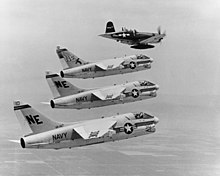
From 1965 through 1969, Garrison was president of Craig Breedlove & Associates. Breedlove held the World Land Speed Record five times in 1965 with a top speed of over 601.1 miles per hour. During 1968, Garrison started to package a deal that saw Utah's Governor, Calvin Rampton provide a hangar facility for the construction of a supersonic car. Bill Lear, of Learjet fame, was to provide support, along with his friend Art Linkletter. Playboy magazine hoped to have the car painted black, with a white bunny on the rudder. TRW was supplying a lunar lander rocket motor. A change in public interest saw the concept shelved for a period of time. The group also negotiated for the use of the late Donald Campbell's wheel-driven Bluebird CN7 record-breaker.[8]

In 1968, the Indian Air Force donated Consolidated B-24 Liberator HE-771, stored at Poona, to Garrison for inclusion in his aircraft collection. It was to be ferried back to the United States in company with the B-24 given to Strategic Air Command. Garrison was busy with Roger Corman's film Von Richthofen and Brown, in 1970, so he turned it over to the RAF. Ultimately, it ended up in Kermit Weeks' museum in Florida.
Garrison published aviation magazine, AVIAN, from 1966 to 1969 with contributions from actor and pilot Richard Bach, Ernest Gann, Ray Bradbury and others. AVIAN started a tradition, with its first issue, including an aviation-oriented poem. The first issue featured “Planes that Land on Grass” by Ray Bradbury while the last issue, Vol, 2, No. 6 featured Lynn Garrison’s Remembrance which has been used over the years by pilots’ groups such as Fighter Pilot University.
Remembrance
The soldier sleeps – in distant foreign lands,
Beneath the ice or shifting desert sands.
An airman in the sun-split clouds.
The sailor in his watery shroud.
Their sacrifice, in time is lost,
With scant appreciation of the cost
Lest we forget.
Lynn Garrison[9]
Cloud seeding
During the 1960s, Irving P. Krick & Associates operated a successful cloud seeding operation in the area around Calgary, Alberta that pumped silver iodide into the atmosphere in an attempt to reduce the threat of hail damage. Garrison, Ralph Langemanand and Stan McLeod (all ex-RCAF), were attending the University of Alberta and spent their summers flying "hail suppression". The program was funded by farmer contributions and government grants. The program is run each summer and does much to reduce damage by hail.[10]
Other activities
In April 1960, Garrison and Harradence became a founding directors of Monarch Savings & Trust, Ltd.,

the last financial institution of its type chartered by the Province of Alberta. In 1963, Garrison also took time away from flying to coordinate Roy Farran's successful campaign for a seat on Calgary City Council.
In 1982, Garrison created The Haitian Children's Fund, a charity to focus on the needs of Haiti's young. During the 2004 Gonaïves hurricane disaster, Garrison coordinated all container donations into Haiti for Prime Minister Gerard Latortue's government. Immediately after the January 12, 2010 earthquake disaster, the fund distributed 10 containers of emergency medical supplies. At the present time, the charity coordinates transfer of young Haitian cardiac patients to the Star Hospital, in India, for free treatment.
During 1989–1992, Garrison operated The Yellow Bird – Galerie d'Art Haitien, a Santa Monica art gallery specializing in Haitian art.
Film projects
In August 1980, as producer and director of a television segment for a series on paranormal subjects, Lynn Garrison set out to film the secrets of Voodoo. Accompanying him were Burt Lancaster and Samantha Eggar. Lancaster was slated to be the host of the series. During an effort to dig up a buried zombie in a cemetery of Desdunes, the team was almost killed by angry peasants. This exciting visit was the foundation for Garrison's 30-year involvement with Haiti.
In 1990 Garrison collaborated with Lou Lenart (Lenart led the first Israeli Air Force attack in May 1948, flying Bf 109s) to create First Strike, a feature film based on Israel's Operation Babylon, the June 7, 1981 attack on Iraq's Osirak nuclear plant. Garrison re-wrote the script and was to direct the aerial sequences utilizing the Israeli Air Force. Walt Disney Productions took over the project and it is still under consideration.
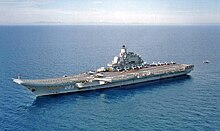
In 1994–1995, Greystone Communications Group gained access to all Russian wartime footage. They planned an aviation series for the History Channel and retained Garrison and Bill Casale to develop the concept. Greystone also received permission to place a five-man crew on board the Russian aircraft carrier Admiral Kuznetsov for a Mediterranean shake-down cruise in 1995. Garrison was to head this team. The DIA approved this concept but the project was delayed until 1996 and by this time Garrison had moved on to other things.
Ireland, the Irish Air Corps and film industry

During 1975, Justin Keating of Ireland’s Fine Gael/ Labour coalition government introduced the first substantial legislation for the development of Ireland’s oil and gas. He worked with Lynn Garrison, a key element in creating Ireland’s Film Act of 1970 to draft the original legislation. Garrison brought petroleum experts from Calgary, Alberta, Canada to assist in the project. The legislation was modeled on international best practice, ensuring the Irish people would gain substantial benefit from their own oil and gas. Under Keating’s legislation the state could acquire a 50 per cent stake, by right, in any viable oil and gas reserves discovered. Production royalties of between 8 per cent and 16 per cent with corporation tax of 50 per cent would accrue to the state. Keating’s legislation specified energy companies would begin drilling within three years of the date of the issue of an exploration license. Over the last 35 years successive governments have legislated away their percentage share of the gas and oil down from 50 per cent to 0 per cent.[11]

Between 1964 and 1965, Garrison worked with the Irish Air Corps to establish a collection of World War I replica fighter aircraft, facilities and support equipment at a facility at Weston Aerodrome, Leixlip, Ireland. This was originally put together in support of 20th Century Fox's 1966 film The Blue Max.[12] The aerial fleet included a sole Caudron 277, two Fokker DR 1s, three Fokker D VIIs, two S.E.5As and two Pfalz D IIIs (all full-scale replicas) four de Havilland Tiger Moths, three SV4C Stampes, a Morane 230 and six Curry Wot 3/4 scale S.E.5As.
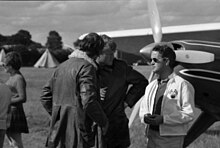
Garrison and the Irish Air Corps continued their relationship and the Corps provided aircrew and engineering staff to support films and television commercials Garrison worked through to the late 1970s. Garrison was also responsible for coordinating the first demonstration of the Marchetti SF-260 Warrior at Baldonnel. As a result of this presentation the Corps acquired a number of Warriors. At the time he was in partnership with James Baring, heir to the Barings Bank estate. Baring was also a well-known demonstration pilot who flew in a number of Garrison's film projects along with John Fairey, of the Fairey Aviation family. Garrison later established new techniques for obtaining aerial footage, creating new camera mounts and special effects.

The Irish Film Act of 1970 set the foundation for an expanding Irish film industry by providing advantageous tax advantages for film productions and resident foreign creative individuals, like Garrison. The Film Act of 1970 was the result of an initial collaboration between Irish Prime Minister (Taoiseach) Jack Lynch and Garrison who had shared a semi-detached house. The Film Act of 1970 became the basis for other national film acts throughout Europe.
Garrison supplied the airfield, equipment and personnel for the Roger Corman movie, Von Richthofen and Brown. He directed the aerial sequences and flew the camera aircraft, a Helio Courier. On September 15, 1970, Charles Boddington, a veteran of The Blue Max and Darling Lili shoots, was killed when his S.E.5 spun in during a low-level maneuver over an airfield. The following day, during the last scheduled flight on the shooting schedule, Garrison and actor Don Stroud were involved in a low-level sequence across Lake Weston, in an Stampe SV.4, when a jackdaw flew through the propeller's arc struck Garrison in the face, knocking him unconscious. The aircraft then ran through five power lines, snap rolled and plunged into the lake inverted. Garrison and Stroud were rescued from the waters; Stroud was uninjured but Garrison required 60 stitches to close a head wound.
During the September 1970 filming of Owen Crump's film, Zeppelin, Garrison's unit lost an Alouette helicopter and S.E.5 in a mid-air collision over Wicklow, Ireland with a loss of five people including Burch Williams, brother of 20th Century Fox executive Elmo Williams. For the film Tora! Tora! Tora!, Garrison and Jack Canary created the large fleet of "Japanese" aircraft. Some of these aircraft still make appearances at air shows.[13] Garrison also worked on Darling Lili, Barry Lyndon, Ryan's Daughter and the TV series "Twelve O'Clock High".
Other film projects
In 1981, Wakusei Robo Danguard Ace (惑星ロボ ダンガードA(エース) su?) was a Japanese science fiction anime series created by Leiji Matsumoto. It was licensed by Jim Terry Productions as part of the Force Five promotion as "Danguard Ace". English dialog was written for re-dubbing by Garrison who then combined a number of episodes into a feature length presentation which gained a cult following on the Showtime network during the 1980s. This series was the forerunner of the 2010–2011 Transformer craze.
Mercenary
Garrison became a mercenary, flying as a combat pilot in various conflicts, then later acting as a military and political advisor, allegedly with the support of a number of US Government agencies and various U.S. senators.
During the Nigerian Civil War (1967–1970), Garrison joined a group of mercenaries fighting for the Biafrans in their effort to create an independent state.[14] In May 1969, Carl Gustaf von Rosen formed a squadron of five Malmö MFI-9 MiniCOIN small piston-engined aircraft (armed with rocket pods and machine guns) known as the Babies of Biafra, which attacked and destroyed Nigerian jet aircraft on the ground and delivered food aid.[15] Garrison coordinated the attacks, destroying an Ilyushin Il-28 bomber and a Mikoyan-Gurevich MiG-17 fighter aircraft. He also introduced a supply-dropping procedure (learned in northern Canada). A bag of grain was enclosed in a larger bag before dropping. When the load hit the ground the inner bag would rupture, while the outer bag contained the contents. Many lives were saved through air drops using this simple concept.[16]
Operation Tiger Claw (October 17–20, 1967) was a military conflict between Nigerian and Biafran military forces. On October 17, 1967 Nigerians invaded Calabar led by the "Black Scorpion", Benjamin Adekunle while the Biafrans were led by Col. Ogbu Ogi, who was responsible for controlling the area between Calabar and Opobo, and Lynn Garrison a foreign mercenary. The Biafrans came under immediate fire from the water and the air. For the next two days Biafran stations and military supplies were bombarded by the Nigerian air force. That same day Lynn Garrison reached Calabar but came under immediate fire by federal troops. By October 20, Garrison's forces withdrew from the battle while Col. Ogi officially surrendered to Gen. Adenkule.
Later in 1969, Garrison flew in the last military conflict involving propeller-driven aircraft (P-51 Mustangs and the Vought F4U Corsairs) during the Football War between El Salvador and Honduras.[17]

At the time, Garrison owned an ex-French Navy Corsair which had operated in Vietnam and during the 1956 Suez Crisis. He purchased it after its retirement from French service and it was transported to the United States for him by the U.S. Navy, stored at Norfolk, and then transferred to California where he was based.[18] It was later used in the TV series Baa Baa Black Sheep, depicting Pappy Boyington's wartime experiences. Later, Garrison was retained by LTV Aerospace president Paul Thayer to do a Bob Hoover aerobatic show to promote Vought's new jet fighter, the LTV A-7 Corsair II but the idea was dropped due to insurance requirements. Garrison went on to do many low-level aerobatic displays in the Corsair, but as a private operator.
It was rumoured that in 1970, Garrison worked to overthrow the Libyan regime of Muammar Gaddafi, though the allegations were never substantiated.[19] Later in the 1970s, Garrison was reported to have flown covert missions with the Helio Courier in South East Asia.[citation needed]
Haitian activities
By August 1991, Garrison was back in the political arena and back in, arguably, a military role as a personal advisor to Haiti's military ruler, Lieutenant General Raoul Cédras,[20] the US Senate and, allegedly, the DIA and CIA.[21] He acted as the interface between the American embassy and Cedras after diplomatic relations were severed. His code name was "'The Shadow".

In June 1992, Garrison, working with Colonel Pat Collins, the Military Liaison Officer with the American embassy, wrote a White Paper visualizing modification of the Forces Armeés d'Haiti (FAdH) into what they called, an Army of the People. This would see the FAdH undertake many projects to support Haiti's population including road building, school and hospital construction, revival of the nation's nation's 23 airfields and interdiction of drug traffic from Central and South America. Mobile medical/dental clinics were to be a major factor in the program, staffed by military personnel. A team of 700 Canadian and American military engineers and technical staffers, was dispatched to Haiti on the USS Harlan County, 11 October 1993, but left Haitian waters when its captain, Commander Butcher, perceived dangers not seen by Colonel J.T.F. Pulley, 7th Special Forces chief on board.[22][23] The 1994 return of President Jean Bertrand Aristide was predicated upon the existence of a restructured FAdH, to act as a counterbalance to his predicted thrust for a dictatorship. To this end, the US military was sending instructors and new equipment, including fast-boats and aircraft, to support the concept. Soon after his return to Haiti, Aristide unconstitutionally attempted disbandment of the FAdH, which, until now, exists on paper and is protected by Article 263 Titre XI de la Constitution de la Republique d'Haiti.
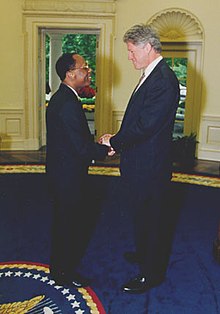
Garrison was accused of running the public relations campaign against former Haitian President Jean-Bertrand Aristide[24] after he accused Aristide, prior to leaving the country, of ordering the murder of eight political opponents.
It would seem that there was some truth in this. In January, 2014 the Haitian court finally moved on one of the cases involving the murder of journalist Jean Dominique, and his security guard. Amelie Baron, of Reuters, reported: “Mirlande Libérus, a former senator from Aristide's political party, was indicted as the organizer of the double murder in April 2000 of Dominique, owner of Radio Haiti Inter, and a security guard, according to a summary of the judge's report made public by an Appeals Court panel on Friday. Evidence in the case indicated that Libérus had been given the directive by Aristide to silence the popular journalist and human rights activist, the report said, citing witnesses who testified before Judge Yvikel Dabrésil.”[25]
Retirement
This section of a biography of a living person needs additional citations for verification. (June 2011) |

In 1992, Garrison was named Haitian Consul to the United States, an appointment he retained in 2010. Garrison has now retired but is writing a third book: HAITI: Coup de Grace, due for release in the near future. He remains a resident of the United States but has continued to work on the project he created in 1987, the Haitian Aerial Reforestation Project (HARP) to scatter tree seeds by aircraft.
In January 2010, Garrison helped to coordinate the airdrop of food and other aid in the aftermath of the 2010 Haiti earthquake. On October 20, 2010, even as the cholera epidemic was reported in central Haiti, Garrison was on the way to the area with a truckload of re-hydration solutions to combat the epidemic.
Garrison’s Haitian Childrens’ Fund is coordinating distribution of donated One World Futbol soccer balls in Haiti as part of a Chevrolet sponsored worldwide project, to which the company donated $15,000,000, to acquire and distribute containers of these undeflatable balls to Third World countries.[26] President Michel Martelly, a soccer enthusiast, is personally assisting with distribution in Haiti.
Honours
In 1973, Garrison was awarded the Paul Tissandier Diploma by the Federation Aeronautique Internationale for his contributions to world aviation. He was recommended by the Royal Canadian Flying Clubs Association.
Ancestry
Garrison’s ancestors migrated from Ireland to Pennsylvania in 1728. Some moved on to Kentucky and then to Marion county, Illinois. Garrison’s great grandfather, William Lloyd Garrison, served with the 40th Illinois Volunteer Infantry Regiment during the American Civil War. He lost his leg in the Battle of Shiloh, and was subsequently released from service on October 18, 1862.[27] In 1904, his son, William Garrison, took the family to homestead in Westlock, Alberta, making the 1500 mile journey in covered wagons. Ivan Garrison, Lynn’s father, was born February 22, 1897 in Enterprise, Illinois. He would serve with the 4th Field Ambulance of the Canadian Army Medical Corps during the First World War, and with the Royal Regiment of Canadian Artillery, during the Second World War. His brother Tim Garrison resided in Prince George, Bc Canada.
References
Notes
- ^ Foreman 2003, p. 18.
- ^ Walker, R. W. R. "RCAF Mustangs 9221 to 9250." ody.ca. Retrieved: December 8, 2011.
- ^ Jenkins, Gordon. "115 ATU UNEF." 115atu.ca. Retrieved: October 4, 2012.
- ^ KB976 and Lynn Garrison by Lynn Garrison (TimeFadesAway.co.uk, last updated 10 July 2013)
- ^ "Surviving Lancaster – Air Museum of Canada." lancaster-archive.com. Retrieved: December 8, 2011.
- ^ BONHAMS AUCTIONS. "Lot 375." .bonhams.com. Retrieved: February 7, 2014.
- ^ Cromer, Peter. "The Journey Begins." Calgarymosquitosociety.com. Retrieved: October 1, 2012.
- ^ Kirshenbaum, Jerry. "Craig Breedlove is the undisputed champion of a sport." Sports Illustrated, April 27, 1970. Retrieved: June 12, 2010.
- ^ Rogers, Jolly. "We Remember." Fighterpilotuniversity.com. Retrieved: October 1, 2012.
- ^ Sheremata, Davis. "Shooting for the clouds." Canadian Geographic. Retrieved: October 7, 2012.
- ^ Collins, Collins. "The Crash, The Bailout And The Theft Of Ireland’s Resources." wearechange.ie. Retrieved: October 6, 2012.
- ^ "History: Blue Max Triplane." blue-max-triplane.org. Retrieved: December 8, 2011.
- ^ Freedman, John. "Mitsubishi Zero VH-ZRO Tora replica Down Under". Australian Flying.com. Retrieved 10/03/2012.
{{cite web}}: Check date values in:|accessdate=(help) - ^ "The Mercenaries." Time magazine, October 25, 1968.
- ^ Gary Brecher. "Biafra: Killer Cessnas and Crazy Swedes." exile.ru, October 15, 2004.
- ^ "Count von Rossen’s Air Force." fly.historicwings.com. Retrieved: October 1, 2012.
- ^ Depner, Wolfgang. "Warfare Without Shooting." Diplomat & International Canada. Retrieved: October 7, 2012.
- ^ Chapman, John et al. "Corsair/BuNo. 133693." warbirdregistry.org. Retrieved: December 8, 2011.
- ^ "Haiti: With Friends Like These." Time Magazine. Retrieved: December 8, 2011.
- ^ "AIM Report: Jesse Jackson's Rapid Resurrection." aim.org. Retrieved: December 8, 2011.
- ^ "Haiti." PR Watch.org. Retrieved: December 8, 2011.
- ^ Diebel, Linda. "Canadian advises Haiti chief." Toronto Star, October 19, 1993.
- ^ Riehm, LtCmdr Peter. "The U.S.S. Harlan County Affair." Military Review, July–August 1997, pp. 31–36.
- ^ Davison, Phil. " 'Shadow' plays dirty tricks in Haiti: A Canadian adventurer is behind the smear campaign against Aristide." The Independent, Retrieved: December 8, 2011.
- ^ Amelie Baron."Nine charged in 2000 murder of Haitian journalist Jean Dominique”.Reuters,January 19, 2014,.
- ^ O'Hanlon, Ryan. "The Soccer Ball That Never Needs Air". Outside Online. Mariah Media Network, LLC. Retrieved 11 December 2012.
- ^ Yarbrough, Carol. "Men of the 40th Regiment Illinois Volunteer Infantry." .carolyar.com. Retrieved: September 23, 2012.
Bibliography
- Garrison, Lynn. Aristide: The Death of a Nation. Fort Lauderdale, Florida: Leprechaun Publishing Group, 2004. ISBN 978-0-9704636-7-8.
- Garrison, Lynn. Voodoo Politics: The Clinton/Gore Destruction of Haiti. Fort Lauderdale, Florida: Leprechaun Publishing Group, 2000. ISBN 978-0-9704636-2-3.
- Garrison, Lynn. EVOLUTION: 90 MPH to Supersonic in 30 years. Portland, Oregon: Bitz Publishing, 2016. ISBN 978-1-4942507-1-3.
